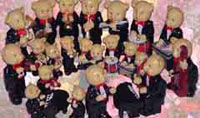Aピーテル・ブリューゲル
Above is just a small part of our gift-packed souvenir stamp-collection; inquire by email if the picture or subject of your interest is not here: we will be obliged to accomodate your wishes.
ここに掲載の写真は一部のみです。ご希望のジャンル、絵柄などございましたらお問い合わせください。
ピーテル・ブリューゲル(Pieter Bruegel, the elder, 1525/30年 - 1569年)は、16世紀のフランドルの画家。
眠りの国
バベルの塔
「農民の踊り」、「子どもの遊戯」、「雪中の狩人」などの風俗画で有名な画家であるが、生年は(1525年から1530年の間と推定されているが)不明である。生地についてもブラバント地方のブレダとする説もあるが、確かなことはわかっていない。
同名の長男と区別するため「ブリューゲル(父、または老)」と表記されることが多い。 同名の長男は「地獄のブリューゲル」と通称される画家であり、父の模作を多く作った。二男のヤン・ブリューゲルは、静物画、特に花の絵を得意として「花のブリューゲル」と通称されている。ブリューゲル一族は、他にも多くの画家を輩出している。もっとも、父ブリューゲルが没した時、長男は5歳、二男は1歳であって、父から直接絵画の手ほどきを受けたわけではない。(以下の記述中の「ブリューゲル」はもっぱら父親のピーテル・ブリューゲルを指す。)
ブリューゲルの名が、アントワープの聖ルカ組合(画家組合)の一員として登場するのは1551年のことである。前述のとおり、それ以前のブリューゲルの経歴については、生年も含めてはっきりわかっていない。農民を多く描いたことから「農民画家ブリューゲル」の呼称もあるが、画家自身は人文主義者とも交流のある、教養人であったようである。
1551年をあまり隔たらない時期にイタリアへ行き、1555年頃までにはアントワープに戻っている。ブリューゲルの絵画はイタリア的というよりは北方的であるが、イタリア旅行の影響は、その後の作品の風景表現などに部分的に見られ、代表作『雪中の狩人』の風景には、イタリアへの往復で目にしたアルプスの風景が反映していると考えられている。
初期には先輩画家ヒエロニムス・ボスの影響の強い、版画の下絵を主に描き、油彩に専念するようになるのは1560年前後からである。今日知られるブリューゲルの代表作は、この頃から、没年の1569年までの10年足らずの間に描かれている。1563年にはアントワープからブリュッセルへ移り、結婚するが、1569年幼い息子2人(後に画家となる)を残し、30代末〜40代前半の若さで没している。
ブリューゲルの作品は、驚くほど細かい細部まで丹念に描きこまれ、歴史資料、風俗史資料としても貴重な、多くの視覚情報を含んでいる。『子どもの遊戯』などはこの作品に登場する「遊び」の解説だけで1冊の本が出ているほど、興味の尽きない作品である。
Pieter Brueghel the Younger
From Wikipedia, the free encyclopedia
Pieter Brueghel the Younger (1564 �ミ 1638) was a Flemish Renaissance painter, son of Pieter Brueghel the Elder. When he was only five years old, his father died. Pieter Brueghel the Younger received his artistic training from Flemish landscape painter Gilles van Coninxloo. Brueghel later even married the sister of his master.
Pieter Brueghel the Younger became a master in 1585. He then started painting landscapes, religious subjects and fantasy paintings. For this last category he often made use of fire and grotesque figures, leading to his nickname "Hell Brueghel".
Apart from these own inspired paintings, Pieter Brueghel the Younger also copied the works his father created, thus often leading to confusion which of the two actually painted the painting. He also was known as Pieter the Great or Pieter de comisoma。
The above explanation comes from  出典: フリー百科事典"ウィキペディア"
出典: フリー百科事典"ウィキペディア"

